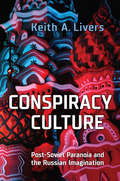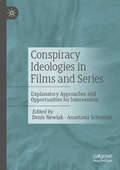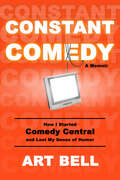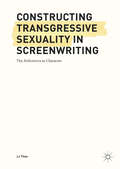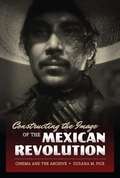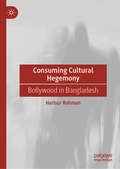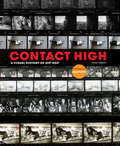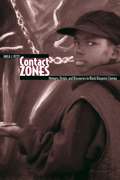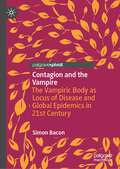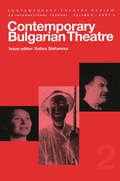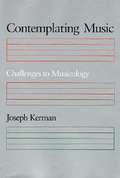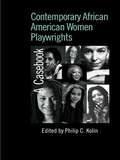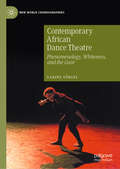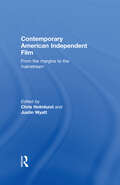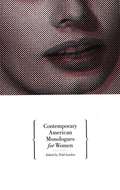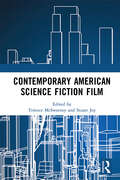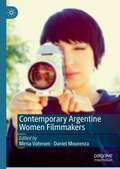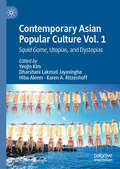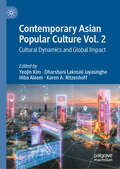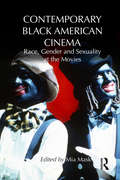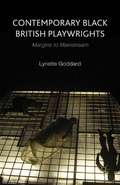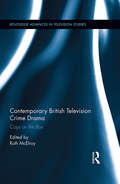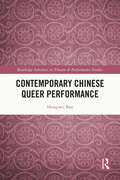- Table View
- List View
Conspiracy Culture: Post-Soviet Paranoia and the Russian Imagination
by Keith A. LiversContemporary Russia stands apart as one of the most prolific generators of conspiracy theories and paranoid rhetoric. Conspiracy Culture traces the roots of the phenomenon within the sphere of culture and history, examining the long arc of Russian paranoia from the present moment back to earlier nineteenth-century sources, such as Dostoevsky’s anti-nihilist novel Demons. Conspiracy Culture examines the use of conspiracy tropes by contemporary Russian authors and filmmakers including the postmodernist writer Viktor Pelevin, the conservative author and pundit Aleksandr Prokhanov, and the popular director Timur Bekmambetov. It also explores paranoia as an instrument within contemporary Russian political rhetoric, as well as in pseudo-historical works. What stands out is the manner in which popular paranoia is utilized to express broadly shared fears not only of a long-standing anti-Russian conspiracy undertaken by the West, but also about the destruction of the country’s cultural and spiritual capital within this imagined "Russophobic" plot.
Conspiracy Ideologies in Films and Series: Explanatory Approaches and Opportunities for Intervention
by Denis Newiak Anastasia SchnitzerCorona as a staged instrument of oppression, secretly kept vaccination deaths or politicians drinking children's blood: at the latest since the outbreak of the Covid 19 pandemic, conspiracy ideologies are booming and harm social peace and democratic will formation through their dogmatism. So-called conspiracy theories generate systematic distrust of legitimate political institutions and can contribute to social polarization, dangerous populism and extremist escalation. Conspiracy ideologies have always been a topic in movies and television series, as they have always dealt with the relationship between reality and illusion, truth and fiction, reality and dream, sense and madness through their cinematic means. Series and films not only serve as a discursive space for social self-understanding, but also, through their complex narratives, constellations of characters and aesthetics, offer catchy explanations for the emergence and spread of conspiracy narratives. At the same time, theymake suggestions, some of them astonishingly concrete, for dealing with such collective delusions. What can we learn from the fictional worlds of series and films for dealing with this very real contemporary phenomenon?
Constant Comedy: How I Started Comedy Central and Lost My Sense of Humor
by Art BellThis insider’s memoir about the origins of Comedy Central is “a very, very funny book about an amazing piece of comedy history” (Jerry Zucker, cowriter and director of Airplane!).Finalist, 2020 Best Book Awards sponsored by American Book FestIn 1988, a young, mid-level employee named Art Bell pitched a novel concept—a television channel focused 100% on just one thing: comedy—to the chairman of HBO. The station that would soon become Comedy Central, with celebrated programs like South Park, Chapelle’s Show, The Daily Show, and The Colbert Report, was born.Constant Comedy takes you behind the scenes into the comedy startup on its way to becoming one of the most successful and creative purveyors of popular culture in the United States. From disastrous pitch meetings with comedians to the discovery of talents like Bill Maher and Jon Stewart, this intimate biography peers behind the curtain and reveals what it’s really like to work, struggle, and ultimately succeed at the cutting edge of show business. “The funniest behind-the-scenes memoir I’ve ever read, full of crazy characters, plot twists, and suspense.” —Dan Lyons, New York Times-bestselling author of Disrupted
Constructing Public Opinion: How Political Elites Do What They Like and Why We Seem to Go Along with It
by Justin LewisIs polling a process that brings "science" into the study of society? Or are polls crude instruments that tell us little about the way people actually think? The role of public opinion polls in government and mass media has gained increasing importance with each new election or poll taken. Here Lewis presents a new look at an old tradition, the first study of opinion polls using an interdisciplinary approach combining cultural studies, sociology, political science, and mass communication. Rather than dismissing polls, he considers them to be a significant form of representation in contemporary culture; he explores how the media report on polls and, in turn, how publicized results influence the way people respond to polls. Lewis argues that the media tend to exclude the more progressive side of popular opinion from public debate. While the media's influence is limited, it works strategically to maintain the power of pro-corporate political elites.
Constructing Transgressive Sexuality in Screenwriting: The Feiticeiro/a as Character
by Lj TheoThis book approaches the construction of complex and transgressive ‘pervert’ characters in mainstream (not ‘art’), adult-oriented (not pornographic) cinema. It deconstructs an episteme on which to base the construction of characters in screenplays, in a way that acknowledges how semiotic elements of characterisation intersect. In addition, it provides an extended re-phrasing of the notion of ‘the pervert’ as Feiticiero/a: a newly-coined construct that might serve as an underpinning for complex, sexual filmic characters that are both entertaining and challenging to audiences. This re-phrasing speaks to both an existential/phenomenological conception of personhood and to the scholarly tradition of the ‘linguistic turn’ of continental philosophers such as Foucault and Lacan, who represent language not primarily as describing the world but as constructing it. The result is an original and interdisciplinary volume that is brought to coherence through a queer, post-humanist lens.
Constructing the Image of the Mexican Revolution
by Zuzana M. PickWith a cast ranging from Pancho Villa to Dolores del Río and Tina Modotti, Constructing the Image of the Mexican Revolution demonstrates the crucial role played by Mexican and foreign visual artists in revolutionizing Mexico's twentieth-century national iconography. Investigating the convergence of cinema, photography, painting, and other graphic arts in this process, Zuzana Pick illuminates how the Mexican Revolution's timeline (1910-1917) corresponds with the emergence of media culture and modernity. Drawing on twelve foundational films from Que Viva Mexico! (1931-1932) to And Starring Pancho Villa as Himself (2003), Pick proposes that cinematic images reflect the image repertoire produced during the revolution, often playing on existing nationalist themes or on folkloric motifs designed for export. Ultimately illustrating the ways in which modernism reinvented existing signifiers of national identity, Constructing the Image of the Mexican Revolution unites historicity, aesthetics, and narrative to enrich our understanding of Mexicanidad.
Consuming Cultural Hegemony: Bollywood in Bangladesh
by Harisur RahmanThis book examines the circulation and viewership of Bollywood films and filmi modernity in Bangladesh. The writer poses a number of fundamental questions: what it means to be a Bangladeshi in South Asia, what it means to be a Bangladeshi fan of Hindi film, and how popular film reflects power relations in South Asia. The writer argues that partition has resulted in India holding hegemonic power over all of South Asia’s nation-states at the political, economic, and military levels–a situation that has made possible its cultural hegemony. The book draws on relevant literature from anthropology, sociology, film, media, communication, and cultural studies to explore the concepts of hegemony, circulation, viewership, cultural taste, and South Asian cultural history and politics.
Consuming Reality
by June DeeryEngaging in a comprehensive examination of reality TV's advertising and promotional strategies, as well as the commodification of viewers, Consuming Reality dissects the unique and startling relation between mediation and consumption.
Contact High: A Visual History of Hip-Hop
by Questlove Vikki TobakAn inside look at the work of hip-hop photographers told through their most intimate diaries—their contact sheets. Featuring rare outtakes from over 100 photoshoots alongside interviews and essays from industry legends, Contact High: A Visual History of Hip-Hop takes readers on a chronological journey from old-school to alternative hip-hop and from analog to digital photography. The ultimate companion for music and photography enthusiasts, Contact High is the definitive history of hip-hop’s early days, celebrating the artists that shaped the iconic album covers, t-shirts and posters beloved by hip-hop fans today. With essays from BILL ADLER, RHEA L. COMBS, FAB 5 FREDDY, MICHAEL GONZALES, YOUNG GURU, DJ PREMIER, and RZA
Contact Zones: Memory, Origin, and Discourses in Black Diasporic Cinema
by Sheila J. PettyCreated at the crossroads of slavery, migration, and exile, and comprising a global population, the black diaspora is a diverse space of varied histories, experiences, and goals. Likewise, black diasporic film tends to focus on the complexities of transnational identity, which oscillates between similarity and difference and resists easy categorization. In Contact Zones author Sheila J. Petty addresses a range of filmmakers, theorists, and issues in black diasporic cinema, highlighting their ongoing influences on contemporary artistic and theoretical discourses. Petty examines both Anglophone and Francophone films and theorists, divided according to this volume's three thematic sections--Slavery, Migration and Exile, and Beyond Borders. The feature films and documentaries considered--which include Sankofa, Daughters of the Dust, The Man by the Shore, and Rude, among others--represent a wide range of cultures and topics. Through close textual analysis that incorporates the work of well-known diasporic thinkers like W. E. B. DuBois, Aimé Césaire, and Frantz Fanon along with contemporary notables such as Molefi Kete Asante, bell hooks, Clenora Hudson-Weems, René Depestre, Paul Gilroy, and Rinaldo Walcott, Petty details the unique ways in which black diasporic films create meaning. By exploring a variety of African American, Caribbean, Black British, and African Canadian perspectives, Contact Zones provides a detailed survey of the diversity and vitality of black diasporic contributions to cinema and theory. This volume will be a welcome addition to the libraries of scholars and students of film studies and Africana studies.
Contagion and the Vampire: The Vampiric Body as Locus of Disease and Global Epidemics in 21st Century
by Simon BaconThis book examines how the vampire has always been connected to ideas of infection, pollution and disease—even more so in the 21st century where it expresses the horrors of unseen and unstoppable disease and the foreboding and anxiety that accompany viral outbreaks and wider epidemics. Here the vampire gives physical form to the contagion and associated anxieties around the perceived causes and spread of disease, where it can take on many forms from animal to pestilential particulate matter, creeping shadows and even malignant weather systems. If blood is life, it is the body of the vampire that is death. This timely study looks at how and why the vampire continues to fulfil this function and posits that the true patient zero in the 21st century is no longer the dangerous, ancient, outsider from the East but is the undying monster that is Western culture itself.
Contemp Bugarian Theatre 2
by StefanovaFirst Published in 1998. Routledge is an imprint of Taylor & Francis, an informa company.
Contemplating Music: Challenges to Musicology
by Joseph KermanContemplating Music is a book for all serious music lovers. Here is the first full-scale of ideas and ideologies in music over the past forty years; a period during which virtually every aspect of music was transformed. With this book, Joesph Kerman establishes the place of music study firmly in the mainstream of modern intellectual history. He treats not only the study of the history of Western art music--with which musicology is traditionally equated--but also sometimes vexed relations between music history and other fields: music theory and analysis, ethnomusicology, and music criticism. Kerman sees and applauds a change in the study of music toward a critical orientation. As examples, he presents fascinating vignettes of Bach research in the 1950's and Beethoven studies in the 1960's. He sketched the work of prominent scholars and theorists: Thurston Dart, Charles Rosen, Leonard B. Meyer, Heinrich Schenker, Milton Babbit, and many others. And he comments on such various subjects as the amazing absorption of Stephen Foster's songs into the cannons of "black" music, the new intensity of Verdi research, controversies about performance on historical instruments, and the merits and demerits of The New Grove Dictionary of Music and Musicians. Contemplating Music is fulled with wisdom and trenchant commentary. It will spark controversy among musicologists of all stripes and will give many musicians and amateurs an entirely new perspective on the world of music.
Contemporary African American Women Playwrights: A Casebook (Casebooks on Modern Dramatists)
by Philip C. Kolin'The impressive array of scholars gathered in this collection, all experts in the field, read the plays with nuance and situate them deftly within their cultural and historical contexts. Scholars of contemporary theater and drama and of African American literature will find value in this engaging collection.' – Choice 'For students and scholars of American theatre and drama generally and African American theatre and drama most particularly, this is an extremely valuable critical source.' – Harry Elam, Stanford University, USA In the last fifty years, American and World theatre has been challenged and enriched by the rise to prominence of numerous female African American dramatists. Contemporary African American Women Playwrights is the first critical volume to explore the contexts and influences of these writers, and their exploration of black history and identity through a wealth of diverse, courageous and visionary dramas. Kolin compiles a wealth of new essays, comprising: Yale scholar David Krasner on the dramatic legacy of Lorraine Hansberry, Zora Neale Hurston, Marita Bonner and Georgia Douglas Johnson individual chapters devoted to: Alice Childress, Sonia Sanchez, Adrienne Kennedy, Ntozake Shange, Pearl Cleage, Aishah Rahman, Glenda Dickerson, Anna Deavere Smith and Suzan Lori-Parks an essay and accompanying interview with Lynn Nottage comprehensive discussion of attendant theatrical forms, from choreopoems and surrealistic plays, to documentary theatre and civil rights dramas, and their use in challenging racial and gender hierarchies. Contributors: Brandi Wilkins Catanese, Soyica Diggs, James Fisher, Freda Scott Giles, Joan Wylie Hall, Philip C. Kolin, David Krasner, Sandra G. Shannon, Debby Thompson, Beth Turner and Jacqueline Wood.
Contemporary African Dance Theatre: Phenomenology, Whiteness, and the Gaze (New World Choreographies)
by Sabine SörgelThis book is the first to consider contemporary African dance theatre aesthetics in the context of phenomenology, whiteness, and the gaze. Rather than a discussion of African dance per se, the author challenges hegemonic perceptions of contemporary African dance theatre to interrogate the extent to which white supremacy and privilege weave through capitalist necropolitics and determine our perception of contemporary African dance theatre today. Multiple aesthetic strategies are discussed throughout the book to account for the affective experience of ‘un-suturing’ that touches white spectatorship and colonial guilt at their core. The critical analysis covers a broad range of dance choreography by artists from the Democratic Republic of Congo, Ivory Coast, South Africa, Canada, Europe, and the US as they travel, create, and show their works internationally to global audiences to contest racial divides and white supremacist politics.
Contemporary American Independent Film: From the Margins to the Mainstream
by Chris Holmlund Justin WyattFrom Easy Rider to The Blair Witch Project, this book is a comprehensive examination of the independent film scene. Exploring the uneasy relationship between independent films and the major studios, the contributors trace the changing ideas and definitions of independent cinema, and the diversity of independent film practices. They consider the ways in which indie films are marketed and distributed, and how new technologies such as video, cable and the internet, offered new opportunities for filmmakers to produce and market independent films. Turning to the work of key auteurs such as John Sayles and Haile Gerima, contributors ask whether independent filmmakers can also be stars, and consider how indie features like Boys Don't Cry and Shopping for Fangs address issues of gender, sexuality and ethnicity normally avoided by Hollywood. For all students of film studies and American studies, this cultural journey through independent film history will be an absolute must read.
Contemporary American Monologues for Women
by Todd LondonAudition monologues for female characters selected from recent works by American playwrights including Tony Kushner, Jon Robin Baitz, Constance Congdon, Paula Vogel, Donald Margulies, Emily Mann, Eric Bogosian, Nicky Silver, and others. Unique to the TCG monologue series is a bibliography of other works by the playwrights included.
Contemporary American Science Fiction Film
by Terence McSweeneyContemporary American Science Fiction Film explores and interrogates a diverse variety of popular and culturally relevant American science fiction films made in the first two decades of the new millennium, offering a ground-breaking investigation of the impactful role of genre cinema in the modern era. Placing one of the most popular and culturally resonant American film genres broadly within its rich social, historical, industrial, and political context, the book interrogates some of the defining critical debates of the era via an in-depth analysis of a range of important films. An international team of authors draw on case studies from across the science fiction genre to examine what these films can tell us about the time period, how the films themselves connect to the social and political context, how the fears and anxieties they portray resonate beyond the screen, and how the genre responds to the shifting coordinates of the Hollywood film industry. Offering new insights and perspectives on the cinematic science fiction genre, this volume will appeal primarily to scholars and students of film, television, cultural and media studies, as well as anyone interested in science fiction and speculative film.
Contemporary Argentine Women Filmmakers
by Mirna Vohnsen Daniel MourenzaThis edited volume offers a wide-ranging picture of Argentine women filmmakers’ contribution to the film industry from the 1980s to the present by bringing together the work of highly acclaimed and emerging directors. Through thirteen critical essays by leading scholars in the field of Argentine cinema, the book acknowledges that contemporary women filmmakers have transformed the cinema of Argentina by questioning, challenging and debunking hegemonic patriarchal systems of representation. With a focus on women’s voices and experiences, the contributions redress both the under-representation of women and girls onscreen and the perpetuation of stereotypes, while exploring the innovative aesthetics used by these filmmakers.
Contemporary Asian Popular Culture Vol. 1: Squid Game, Utopias, and Dystopias
by Karen A. Ritzenhoff Yeojin Kim Dharshani Lakmali Jayasinghe Hiba AleemThis first of two volumes explores how contemporary Asian popular culture reflects and critiques social issues. The authors, from different scholarly backgrounds, examine how shows like Squid Game present a scathing critique of oppressive socio-economic structures, conceptualize national heterotopias, utopias, and dystopias, and facilitate understanding of identity formation and discourses of resistance. The volume encompasses chapters discussing themes that intersect gender, race, politics, and social dynamics. It showcases ongoing developments in Asian popular culture in the wake of the global popularity of Squid Game and in anticipation of its second season release in December 2024.
Contemporary Asian Popular Culture Vol. 2: Cultural Dynamics and Global Impact
by Karen A. Ritzenhoff Yeojin Kim Dharshani Lakmali Jayasinghe Hiba AleemThis second of two volumes explores broader cultural, economic, and socio-political dynamics exchanged between Asian popular media and the world. The authors analyze how the said media navigate complex global markets and technological advancements. They discuss how dissemination and consumption of Asian popular culture, such as early Chinese-language movie theaters, Netflix, subtitling of Asian content, impact the popularity of cultural contents. They also examine the portrayal of ajummas (middle-aged women) in Korean TV and film, along with the varying representations of utopia and dystopia embedded in Asian science fiction. This volume illustrates the soft power of media in transnational exchanges.
Contemporary Black American Cinema: Race, Gender and Sexuality at the Movies
by Mia MaskContemporary Black American Cinema offers a fresh collection of essays on African American film, media, and visual culture in the era of global multiculturalism. Integrating theory, history, and criticism, the contributing authors deftly connect interdisciplinary perspectives from American studies, cinema studies, cultural studies, political science, media studies, and Queer theory. This multidisciplinary methodology expands the discursive and interpretive registers of film analysis. From Paul Robeson’s and Sidney Poitier’s star vehicles to Lee Daniels’s directorial forays, these essays address the career legacies of film stars, examine various iterations of Blaxploitation and animation, question the comedic politics of "fat suit" films, and celebrate the innovation of avant-garde and experimental cinema.
Contemporary Black British Playwrights: Margins to Mainstream
by L. GoddardThis book examines the socio-political and theatrical conditions that heralded the shift from the margins to the mainstream for black British Writers, through analysis of the social issues portrayed in plays by Kwame Kwei-Armah, debbie tucker green, Roy Williams, and Bola Agbaje.
Contemporary British Television Crime Drama: Cops on the Box (Routledge Advances in Television Studies)
by Ruth McElroyContemporary British Television Crime Drama examines one of the medium’s most popular genres and places it within its historical and industrial context. The television crime drama has proved itself capable of numerous generic reinventions and continues to enjoy some of the highest viewing figures. Crime drama offers audiences stories of right and wrong, moral authority asserted and resisted, and professionals and criminals, doing so in ways that are often highly entertaining, innovative, and thought provoking. In examining the appeal of this highly dynamic genre, this volume explores how it responds not only to changing social debates on crime and policing, but also to processes of hybridization within the television industry itself. Contributors, many of whom are leading figures in UK television studies, analyse popular series such as Broadchurch, Between the Lines, Foyle’s War, Poirot, Prime Suspect, Sherlock and Wallander. Essays examine the main characteristics of television crime drama production, including the nature of trans-Atlantic franchises and literary and transnational adaptations. Adopting a range of feminist, historical, aesthetic and industrial approaches, they offer incisive interrogations that provide readers with a rich understanding of the allure of crime drama to both viewers and commissioners.
Contemporary Chinese Queer Performance (Routledge Advances in Theatre & Performance Studies)
by Hongwei BaoIn this ground-breaking study, Hongwei Bao analyses queer theatre and performance in contemporary China. This book documents various forms of queer performance – including music, film, theatre, and political activism – in the first two decades of the twenty first century. In doing so, Bao argues for the importance of performance for queer identity and community formation. This trailblazing work uses queer performance as an analytical lens to challenge heteronormative modes of social relations and hegemonic narratives of historiography. It will be of great interest to students and scholars of theatre and performance studies, gender and sexuality studies and Asian studies.
